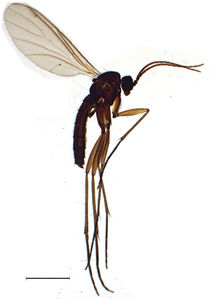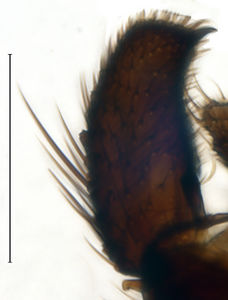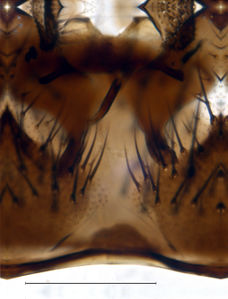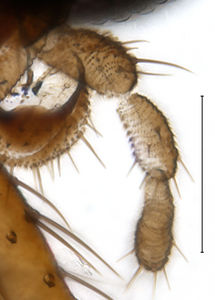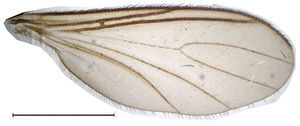Trichosiopsis andreae
Ordo: Diptera
Familia: Sciaridae
Genus: Trichosiopsis
Name
Trichosiopsis andreae unpublished
Type material
Holotype: ♂, 8.5.–15.5.2013, Malaise trap, leg. SDEI, ZFMK-TIS-2507173 in ZFMK
Type locality
Germany, Brandenburg, Groß-Ziethen
Other material studied
Germany: 2 ♂, Brandenburg, Brodowin b. Eberswalde, Trockenrasen, kl. Rummelsberg, Malaise trap, Sommer, 06.05.1993, SDEI 3385/3386; 1 ♂, Golzow b. Eberswalde, Ackerrand/Wald, Malaise trap, Sommer, 29.04.1993, SDEI 3388; 1 ♂, Groß Ziethen, Kernberge, Malaise trap, SDEI, 8.-15.05.2013, PKHH 8327; 2 ♂, 29.5.-05.06.2013, PKHH 8329; 2 ♂, 10.-17.06.2013, PKHH 8331/8332; 2 ♂, Klein Ziethen b. Eberswalde, Serwester See, Ackerfläche, Trockenrasen, Sommer, 29.04.1993, SDEI 3387/3415; 2 ♂, 06.05.1993, SDEI 3384 [all previous SDEI material as Leptosciarella rejecta in Mohrig & Menzel (1997 [1]: 62)]; Italy: 3 ♂, South Syrol, Stilfzer Joch NP, Suldental bei Schmelz, montaner Fichtenwald, Malaise trap, Lange & Ziegler, 17.-21.05.2005, SDEI 2684/2678/2680; 2 ♂, 21.-31.05.2005, SDEI 2566/2568; 1 ♂, Suldental bei Schmelz, submontaner Kiefern-Mischwald, Malaise trap, Lange & Ziegler, SDEI 2507; 1 ♂, Suldental bei Schmelz, montaner Fichtenwald, Malaise trap, Lange & Ziegler, SDEI 2571.
Description (male)
Head. Eye bridge 4–5 rows of facets. Antenna unicolour. LW-index of 4th flagellomere 2.4–2.8; neck 0.25–0.35 × segment width; transition of basal part to neck pronounced. Colour of neck unicolour. Antennal setae shorter than segment width; of normal strength. Palpus darkened; of normal length; palpomeres 3. First palpomere of normal shape; with 3–4 setae; with only sparse sensilla. Second palpomere short and oval. Third palpomere as long as first. Thorax. Colour brown. Notum unicolour. Thoracic setae long and strong; black. Posterior pronotum setose. Postpronotal setae 2–3; strong. Mesothoracic sclerites bare. Legs. Colour brown. Hind coxa darkened. Setae on front coxa black. Front tibial organ as patch of setae; dark; front tibial organ not bordered. Tibial setae on hind legs normal, shorter than tibial width. Tibial spurs of equal length. Claws untoothed. Wing. Wing slightly darkened; of normal shape, or with weakly developed anal lobe. Wing membrane without macrotrichia. Wing venation weak, with faint stM. M-fork of normal shape. R1 ending at or slightly before base of m-fork; posterior veins with macrotrichia; stM mostly with macrotrichia; CuA1 and CuA2 mostly with macrotrichia; bM bare; r-m mostly setose; bM:r-M 0.95–1.15; st-Cu:bM 0.3–0.4; R1:R 1.2–1.45; c:w 0.61–0.72. Halter darkened; of normal length. Abdomen. Abdominal setae strong; on tergites black; on sternites black. Hypopygium concolour with abdomen; LW-index 0.7–0.9. Base of gonocoxites with strong setae; gonocoxites narrowly separated; inner margin of gonocoxites typically U-shaped; inner membrane of hypopygium scarcely setose; ventral margin of gonocoxite with short setae. Gonostylus elongate; LW-index 2.3–2.7; Inner margin concave; apex with one obtuse angle. Apical tooth present; without internal structure; of medium strength; LW-Index 2.1–2.6. Awl-like setae normal; present beneath apical tooth. Megasetae absent. Whiplash-hair absent. Tegmen 0.5–0.65 × longer than broad; rectangular with rounded edges; without special features; central process absent. Length of ejaculatory apodeme/hypopygium 22–32 %; base of ejaculatory apodeme present. Field with aedeagal teeth inconspicuous. Measurements. Body size 2.5–3.2 mm. Hind tibia 1.35–1.6 mm. Wing length 2.6–3.5 mm.
Diagnosis
The species is placed in the Trichosiopsis rejecta group and can be distinguished from other, similar species by the combination of the following characters: strong setae at the base of the gonocoxites, strong and black setae at the fore coxae, gonostylus slender and with an apico-dorsal angle, palpi of typical length and dark, posterior pronotum with setae, length of tibial spines nearly the width of tibia.
Tr. andreae resembles Trichosiopsis suecica and Trichosiopsis defecta, but has darker legs. Particularly the darkening of the fore coxa is a distinguishing character. The gonostylus is more elongate than in most other species of the rejecta group and the slight bulge beneath the apical tooth bearing the two ventral awl-like setae, which is visible only in perfectly mounted specimens, resembles the species around Trichosiopsis pilosa. But species of the pilosa group can be distinguished by the weaker setae at the base of the gonocoxites and the apically more rounded gonostylus.
DNA Barcoding
The COI sequences are assigned to two different BINs:
- BIN BOLD:ACO9227 (average distance 0.31%, max. 0.76%, n=5, K2P: 2.29%)
- BIN BOLD:ACZ9762 (n=1, K2P: 2.29%)
Etymology
The species is named after Andrea Gollner, Innsbruck, for her important contribution to the understanding of Sciaridae phylogeny, based on DNA studies.
Discussion
Leptosciarella andreae is one more species, which was formerly treated under the name Leptosciarella rejecta by Mohrig and Menzel (1997)[1]. It is indeed very difficult to separate from other species in this complex, but shows a very distinct DNA barcode, which is not particularly similar to other known species. It is therefore not a typical "cryptic species", but only has not very distinctive characters. Tr. andreae is genetically di- or possibly even polymorphic. A further BIN beside the typical variant from Germany is treated as a separate subspecies.
Subspecies list
Trichosiopsis andreae andreae - Trichosiopsis andreae gollnerae
Distribution
Gernany.
Images
|
